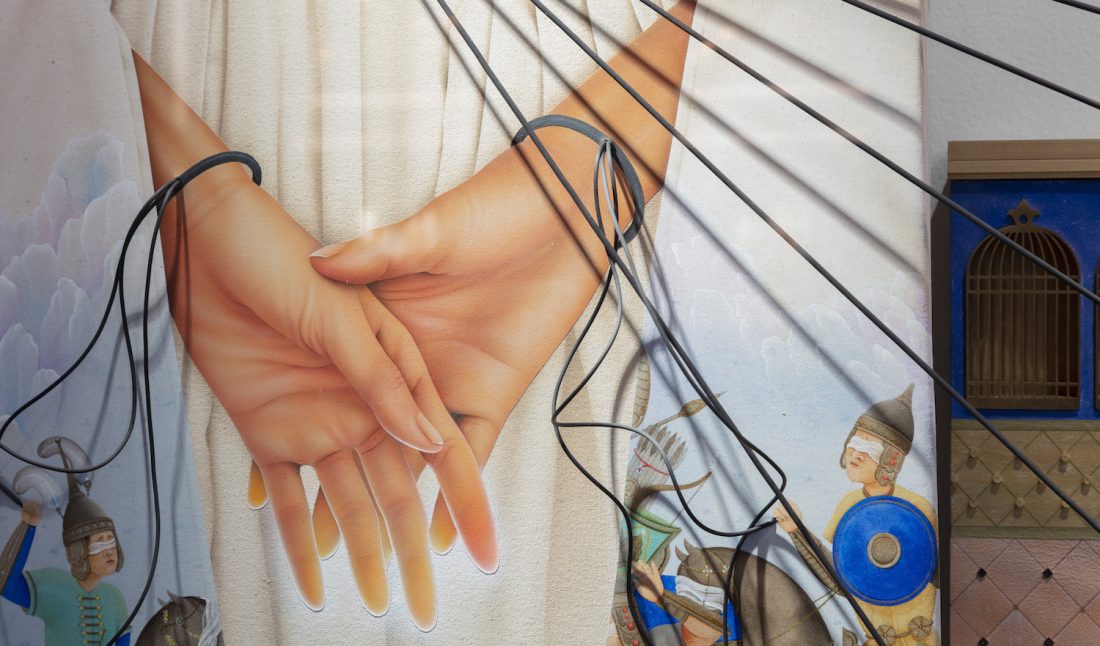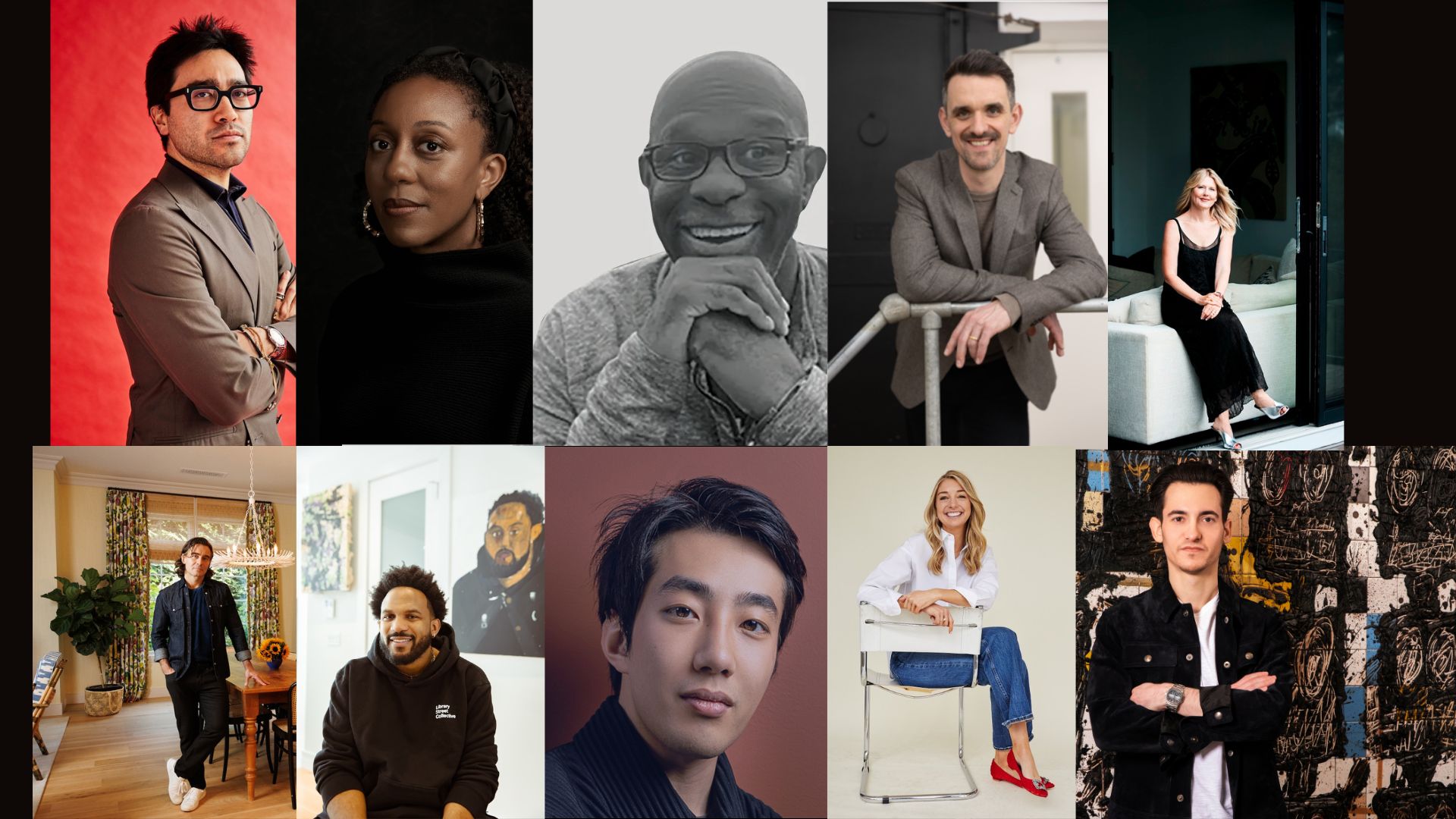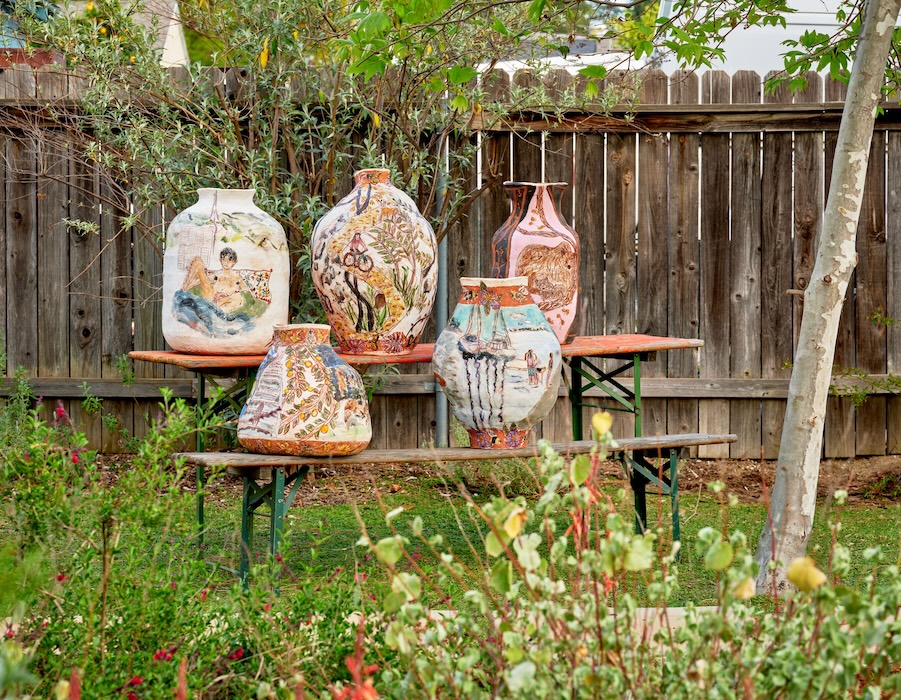On September 6, Rockefeller Center and Art Production Fund unveiled their Art in Focus partnership with US-based Iranian artist Arghavan Khosravi. Currently on view through November 10, the vibrant and moving exhibition is brimming with fearless creative and political intention and is freely open to viewer interpretation. “We are so thrilled to present Khosravi’s exquisite sculptural compositions and imagery at Rockefeller Center this fall,” said Art Production Fund’s Casey Fremont. “These works are intricately detailed, offering the public an opportunity to spend time examining the complex layers and contemplating the important subjects that Khosravi explores.”
Grand and evocative female-centric murals invoke specific cultural and historical painting practices but are radically re-interpreted in Khosravi’s deft hands. The artist gives a powerful voice to the unheard, the unseen, and even the forgotten. Three site-specific installations present Khosravi’s signature hypnotic pieces for the very first time. An energetic dialogue emerges between contemporary and traditional art, with the surrounding classic mid-century architecture, among an international audience and community.
Whitewall had the opportunity to speak with Khosravi about the power of protest, finding beauty in contradiction, and viewing her work in the aftermath of the horrific death of Mahsa Amini.
WHITEWALL: Persian miniature painting and the traditionally subservient role of women in those works has been of deep inspiration for you. How do you subsequently subvert this tradition in your complex, large-scale murals?
ARGHAVAN KHOSRAVI: There is a lack of agency for women in those historic works, as you also mentioned. I appropriated scenes from Persian miniature paintings, detached from their original story. I narrated my own story, a story in which women are portrayed in a way that has a dominant presence and agency while men are either absent or depicted in groups that suggest a lack of individuality (for example, battle scenes).
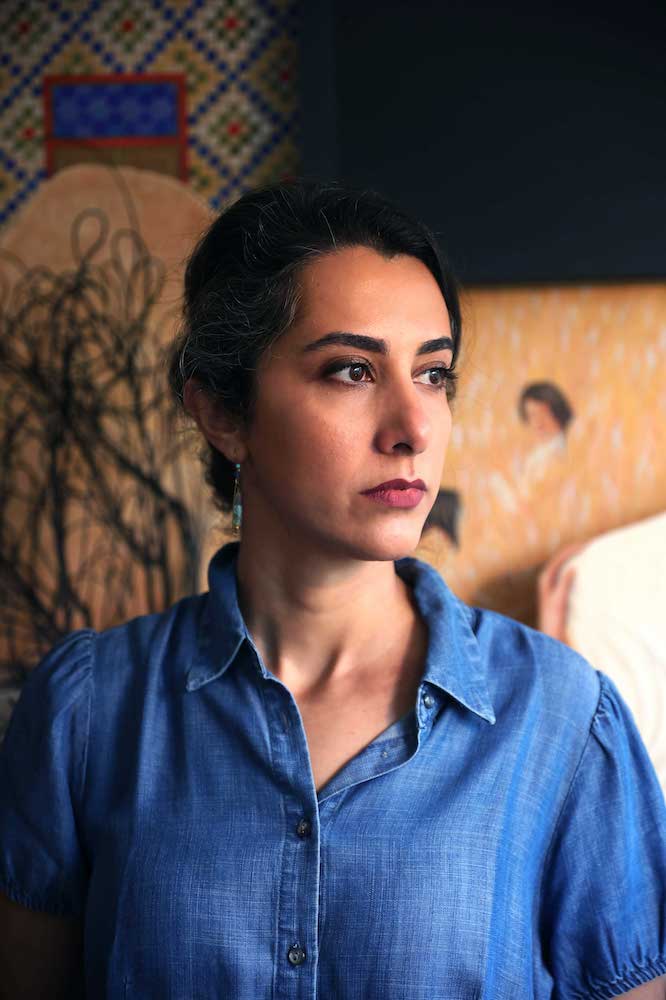 Photo by Hossein Fatemi, courtesy of the artist.
Photo by Hossein Fatemi, courtesy of the artist.
WW: You have stated that public art is intriguing to you because it draws upon a wider audience and creates a larger dialogue around the work. Did you create your most recent works with this in mind?
AK: As with all of my other works, I did not consider who the audience would be when I began working on the site-specific installations at Rockefeller Center. I sometimes feel that considering this might limit my creativity. Since my paintings are infused with symbolism and visual metaphor, they are generally open to multiple interpretations around the core idea they represent. Typically, the text accompanying an exhibition provides context for the work. As this is a public art piece, I chose to keep the wall text less specific and not provide viewers with a guide through which they can interpret the symbols.
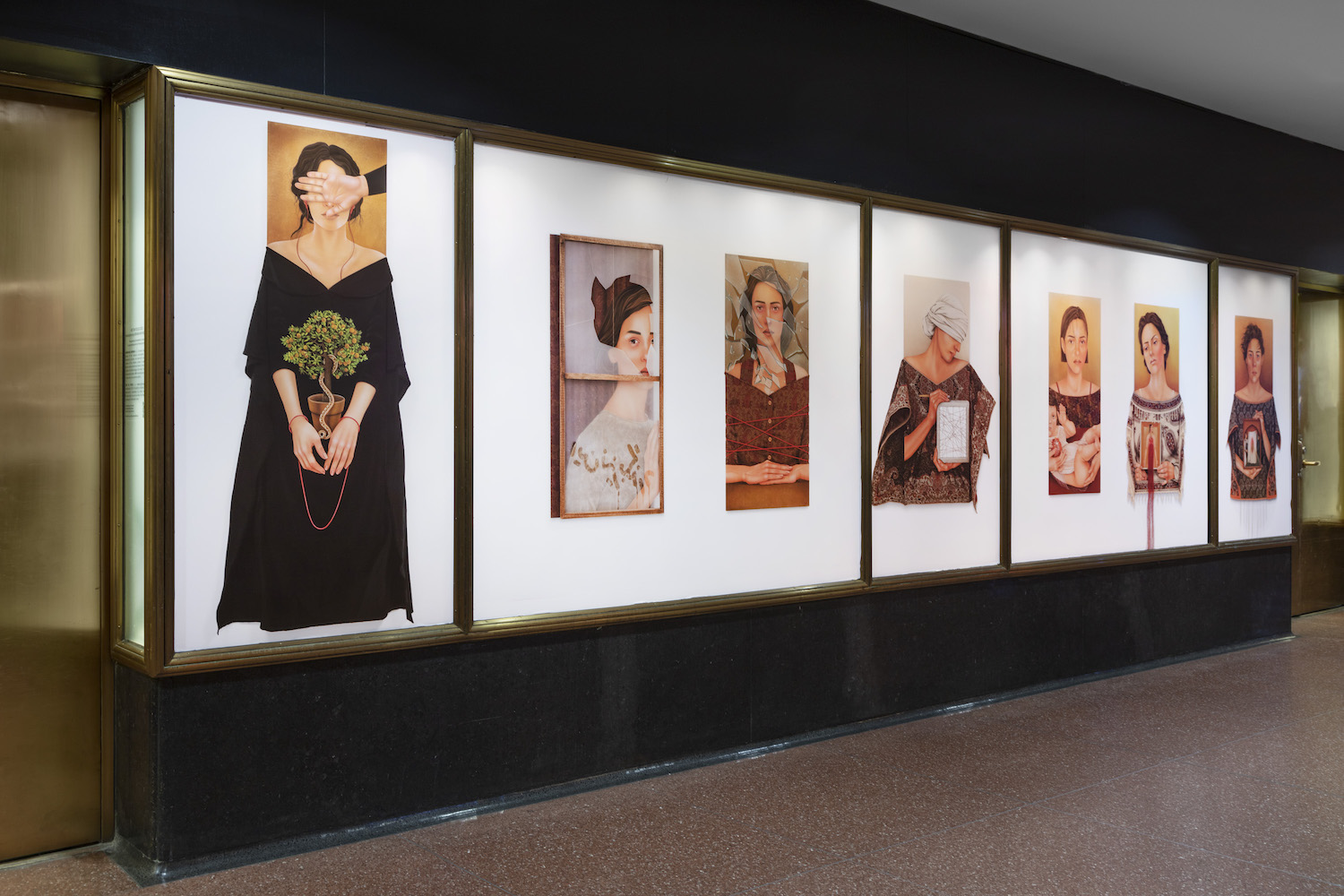 Installation view of Arghavan Khosravi’s exhibition with Rockefeller Center and Art Production Fund; photo by Daniel Greer, courtesy of Art Production Fund.
Installation view of Arghavan Khosravi’s exhibition with Rockefeller Center and Art Production Fund; photo by Daniel Greer, courtesy of Art Production Fund.
WW: In the past, your paintings have reflected particularly on women’s rights issues in Iran. How do you see that in relation to the current protests taking place in Iran?
AK: Similarly to my past paintings, this body of work is inspired by my life experiences and memories from Iran, and therefore women’s rights are a key theme of the work. According to my previous answer, the only difference in this exhibition is that I chose not to discuss it extensively in the press release. I went through my past paintings and started posting them on my social media after the tragic and horrific death of Mahsa Amini in the custody of the Iranian “Morality Police” and the subsequent protests in Iran. It was my intention to show solidarity with Iranian women and men who were protesting in the streets and to spread awareness of these events. All of these paintings can be understood as works that I have painted in response to these events (the feedback I received also suggested the same) although they were all painted before these events took place. In other words, Iranian women have been dealing with and struggling with these issues for more than four decades. In the aftermath of Mahsa Amini’s murder, Iranian women (and men) were no longer able to tolerate it, which resulted in more powerful and robust protests and outrage all over the country, which have received increased media coverage throughout the world.
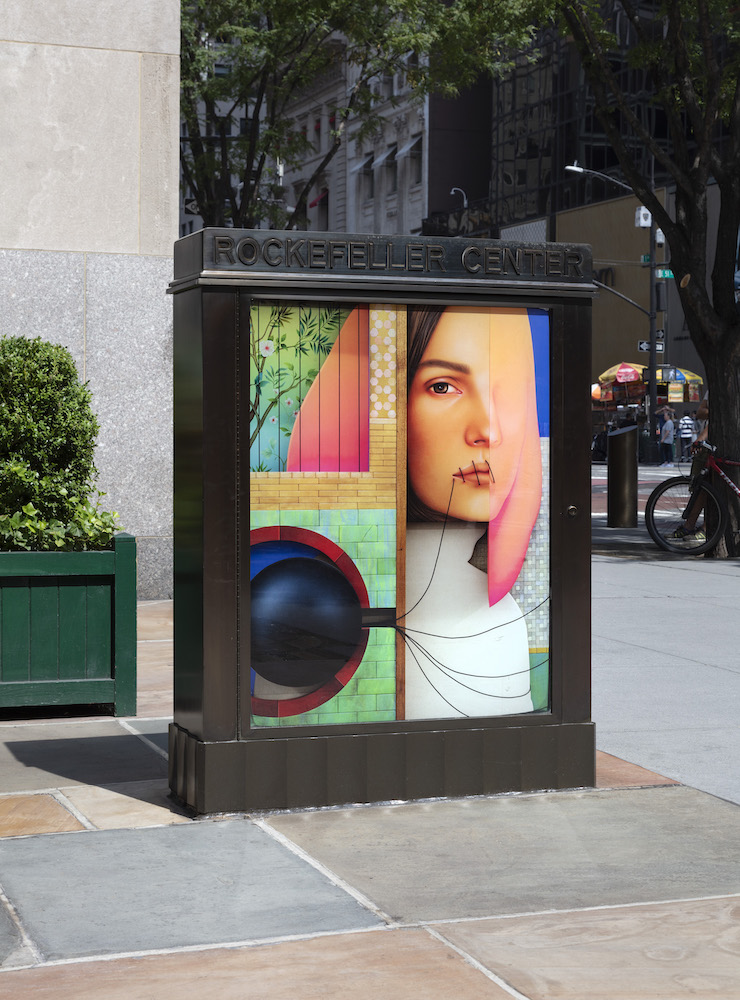 Installation view of Arghavan Khosravi’s exhibition with Rockefeller Center and Art Production Fund; photo by Daniel Greer, courtesy of Art Production Fund.
Installation view of Arghavan Khosravi’s exhibition with Rockefeller Center and Art Production Fund; photo by Daniel Greer, courtesy of Art Production Fund.
WW: Your sculptural compositions play seamlessly with the light and the dark in both palette and metaphor. What is your process like?
AK: In my work, I explore the concept of contradiction extensively, which also reflects on my life experiences from Iran. The contradiction between our lives in private spaces (in which we have freedom) and our lives in public spaces (in which so many unjust rules are dictated on us and there are a lot of restrictions, for example, the compulsory hijab). I am interested in exploring different ways to incorporate contradiction into my work, as you pointed out accurately. Whether it is in the material aspects of the work (for example, the color palette, the use of unconventional materials such as cement, and found objects) or the conceptual or symbolic elements (for example, I appropriate imagery from an Eastern context and juxtapose it with imagery from the Western context, or the religious versus the secular, or the past versus the contemporary). In addition to these, sometimes this contrast is achieved through a combination of materials and concepts (for instance, I use bright, vibrant colors that are associated with positive feelings, while a dark and not-so-pleasant narrative is transpiring in the scene.)
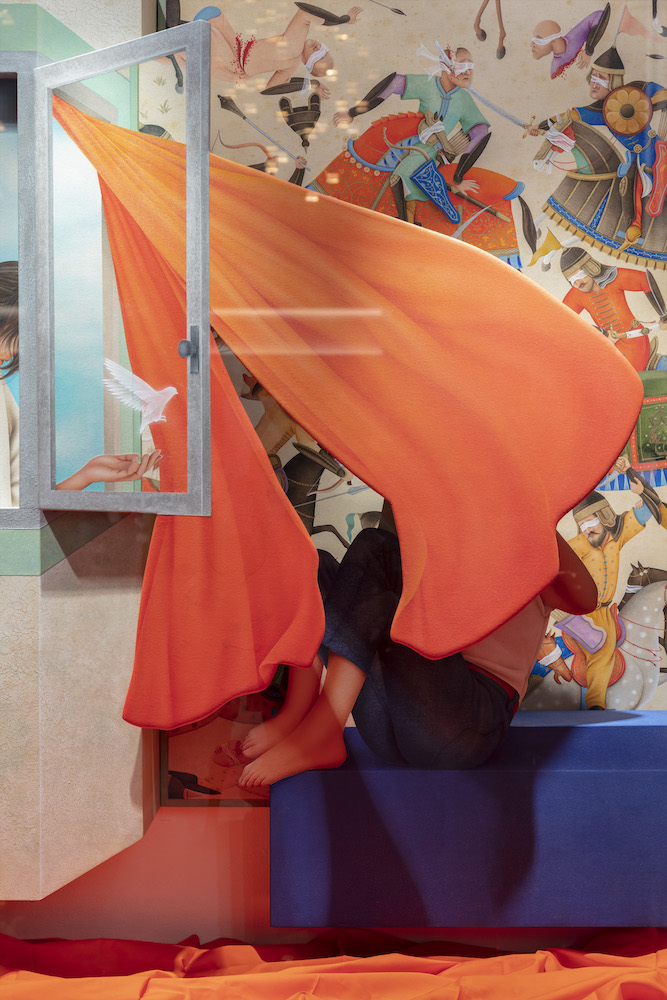 Installation view of Arghavan Khosravi’s exhibition with Rockefeller Center and Art Production Fund; photo by Daniel Greer, courtesy of Art Production Fund.
Installation view of Arghavan Khosravi’s exhibition with Rockefeller Center and Art Production Fund; photo by Daniel Greer, courtesy of Art Production Fund.
WW: You have said that you imagine yourself as a DJ rather than a composer, sourcing various images from fashion photography to life’s objects as inspiration. Has this always been a factor in your artistry or did it develop over time?
AK: As a matter of fact, this was something that developed over time. There were times when I found the blank canvas intimidating, and I needed something in my creative process in order to overcome that and activate my creativity. As I explored different ways to accomplish this, I discovered that I am most creative when I react to an existing image rather than starting from scratch. To begin with, I silkscreen or inkjet printed found images on paper and used them as the foundation of my paintings. Then I painted my own story on top of these existing images. As I moved forward with my next series, I used found textiles as my canvas, and I was able to reconcile with the blank canvas after that. However, I kept the idea of having existing images as a starting point for each painting. It was just moved to the sketching/studying phase of the whole process, not the painting part. That’s why I used the DJ analogy.
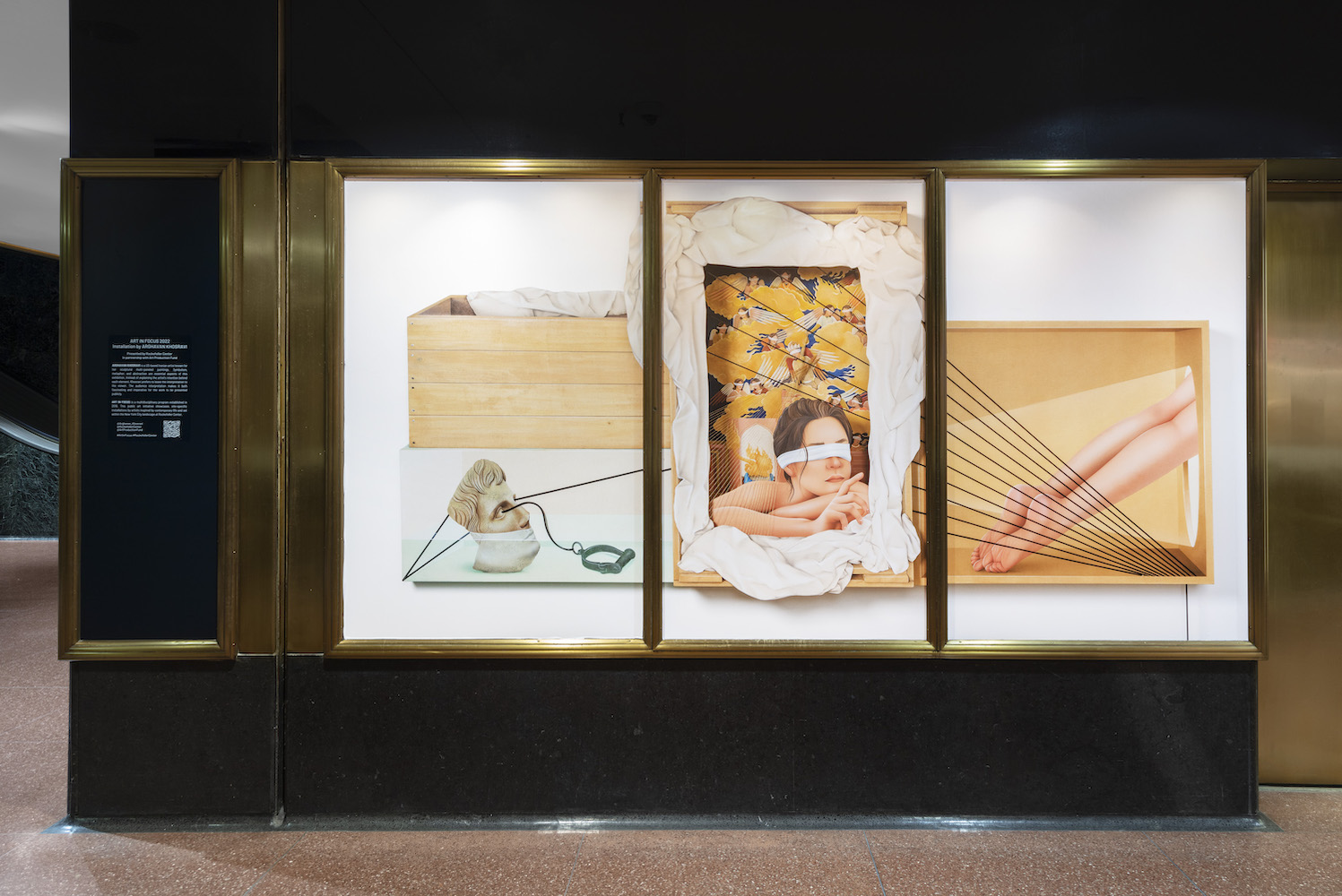 Installation view of Arghavan Khosravi’s exhibition with Rockefeller Center and Art Production Fund; photo by Daniel Greer, courtesy of Art Production Fund.
Installation view of Arghavan Khosravi’s exhibition with Rockefeller Center and Art Production Fund; photo by Daniel Greer, courtesy of Art Production Fund.
WW: You have stated that when creating last year’s exhibition “In Between Places” for Rachel Uffner Gallery in New York, you had to move from a studio space to working in your apartment during the pandemic. How was this limitation reflected in your artwork?
AK: I was unable to work on large paintings due to a lack of space and I did not like the idea that the current situation and these limitations dictated the scale of my work. Therefore, I decided to make even larger works, but instead of working on one large panel, I decided to create multiple smaller panels work on each one separately, and then eventually assemble them to create the final large artwork. Then I realized I could have different depths or even shapes for each of those panels, so my works became more sculptural. As these works became more three-dimensional, I began to use found objects such as ropes, elastic cords, and locks and chains.
WW: What will you be working on next?
AK: In November 2022, I will have my second solo exhibition at Stems Gallery in Brussels, and I am currently preparing for that exhibition.
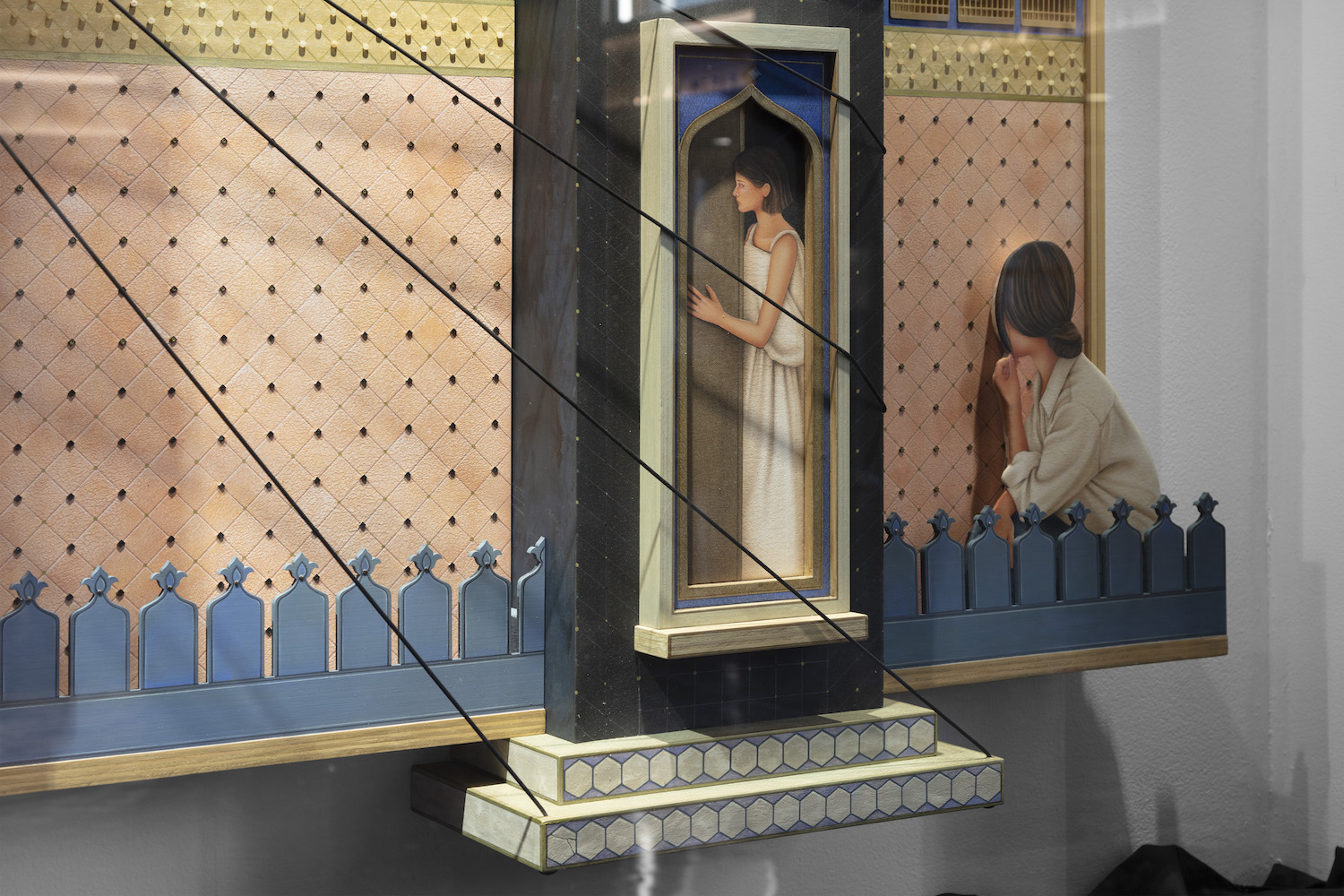 Installation view of Arghavan Khosravi’s exhibition with Rockefeller Center and Art Production Fund; photo by Daniel Greer, courtesy of Art Production Fund.
Installation view of Arghavan Khosravi’s exhibition with Rockefeller Center and Art Production Fund; photo by Daniel Greer, courtesy of Art Production Fund.







